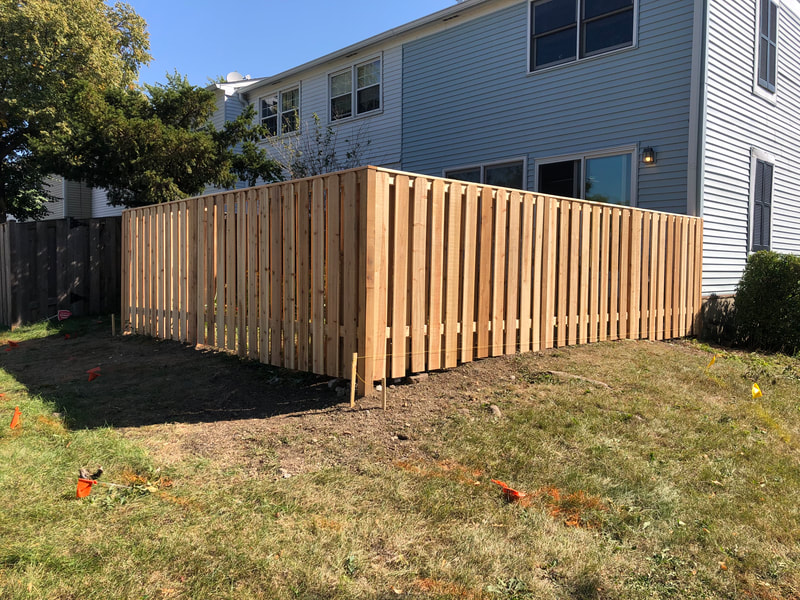Cedar Fence Company
Naperville IL
Naperville Cedar Fence Company, based in Naperville, Illinois, has established itself as a prominent and respected provider of fencing solutions within the community and beyond. This comprehensive exploration will delve into various aspects of the company, including its history, services, product quality, customer service ethos, community involvement, and the impact of its presence in Naperville.
Historical Background and Growth of Cedar Fence Company
Cedar Fence Company's journey began in 2020, rooted in a deep passion for crafting quality fences and a commitment to customer satisfaction. Initially a small local business, it grew steadily, reflecting the growing demands of the Naperville community and surrounding areas. The evolution of the company is a story of entrepreneurship, adaptation to changing market demands, and consistent quality.
Historical Background and Growth of Cedar Fence Company
Cedar Fence Company's journey began in 2020, rooted in a deep passion for crafting quality fences and a commitment to customer satisfaction. Initially a small local business, it grew steadily, reflecting the growing demands of the Naperville community and surrounding areas. The evolution of the company is a story of entrepreneurship, adaptation to changing market demands, and consistent quality.
Cedar Fence Company Naperville IL
Cedar, a highly revered and sought-after material for fencing, stands out for its unique characteristics and benefits. This detailed exploration will cover the origins, properties, benefits, maintenance, environmental impact, aesthetic versatility, durability, and comparison with other materials, making cedar an ideal choice for fencing.
Origins and Types of Cedar Used in Fencing
Cedar wood, derived from various types of cedar trees, is predominantly sourced from areas in North America. The most commonly used types for fencing include Western Red Cedar, known for its exceptional durability and natural beauty, and Eastern White Cedar, prized for its fine grain and stability. Each type of cedar has unique characteristics that make it suitable for different fencing needs.
Physical and Chemical Properties
Cedar wood is known for its lightweight yet sturdy nature, making it a practical choice for fencing. Its cellular structure makes it an excellent insulator, helping to keep properties cooler in summer and warmer in winter. Cedar also contains natural oils that act as preservatives, granting it a high resistance to decay, rot, and insect infestation.
Aesthetic Appeal and Versatility
One of the most appealing aspects of cedar is its natural beauty. The wood has a warm tone with a distinctive grain pattern that can range from a light amber to a rich reddish-brown. Over time, it ages gracefully, acquiring a silvery-grey patina that many find attractive. This aesthetic versatility allows cedar fences to blend seamlessly with various landscape and architectural styles, from modern to rustic.
Durability and Longevity
Cedar’s natural oils not only protect it from rot and insects but also contribute to its longevity. When properly maintained, a cedar fence can last for several decades, making it a cost-effective long-term investment. This durability is a key factor in its popularity for outdoor applications like fencing.
Maintenance Requirements
While cedar is low-maintenance compared to other woods, some care is needed to maximize its lifespan. Regular cleaning, occasional staining or sealing, and prompt repairs of any damage help maintain its appearance and structural integrity. This maintenance routine ensures the fence remains both functional and visually appealing over the years.
Environmental Impact and Sustainability
Cedar is a sustainable choice for environmentally conscious consumers. Many cedar forests are responsibly managed and certified, ensuring sustainable harvesting practices. Additionally, cedar’s natural durability means less frequent replacement and treatment, reducing the environmental impact over its lifespan.
Comparison with Other Fencing Materials
When compared to other materials like vinyl, metal, or treated woods, cedar stands out for its natural beauty and eco-friendliness. Unlike synthetic materials, cedar is biodegradable and has a smaller carbon footprint. While metal and treated woods offer their own benefits, they lack the natural appeal and environmental friendliness of cedar.
Cost-Effectiveness
The initial cost of cedar fencing might be higher than some other materials, but its durability and low maintenance requirements make it a cost-effective choice in the long run. The reduced need for replacements and repairs offsets the initial investment, making cedar a financially savvy option for homeowners.
Installation and Customization
Cedar’s workability makes it a favored choice for custom fencing projects. It can be easily cut, shaped, and assembled into various designs, from traditional picket fences to more contemporary styles. This flexibility allows homeowners to create unique fences that reflect their personal style and meet specific functional needs.
Market Trends and Popularity
The popularity of cedar fencing continues to grow, driven by its natural beauty, durability, and sustainability. This trend is evident in the increasing number of homeowners and builders opting for cedar over alternative materials. The growing awareness of environmental issues and the shift towards sustainable living are further bolstering its appeal.
Cedar Fence Installation in Naperville IL
Cedar stands as an exemplary material for fencing, combining aesthetic appeal, durability, environmental sustainability, and versatility. Its natural beauty enhances property aesthetics, while its inherent properties ensure longevity and low maintenance. As a sustainable resource, it appeals to environmentally conscious consumers, further solidifying its position in the market. Cedar’s ability to adapt to various design preferences and its overall cost-effectiveness make it an ideal choice for those looking to invest in high-quality, long-lasting fencing.
Origins and Types of Cedar Used in Fencing
Cedar wood, derived from various types of cedar trees, is predominantly sourced from areas in North America. The most commonly used types for fencing include Western Red Cedar, known for its exceptional durability and natural beauty, and Eastern White Cedar, prized for its fine grain and stability. Each type of cedar has unique characteristics that make it suitable for different fencing needs.
Physical and Chemical Properties
Cedar wood is known for its lightweight yet sturdy nature, making it a practical choice for fencing. Its cellular structure makes it an excellent insulator, helping to keep properties cooler in summer and warmer in winter. Cedar also contains natural oils that act as preservatives, granting it a high resistance to decay, rot, and insect infestation.
Aesthetic Appeal and Versatility
One of the most appealing aspects of cedar is its natural beauty. The wood has a warm tone with a distinctive grain pattern that can range from a light amber to a rich reddish-brown. Over time, it ages gracefully, acquiring a silvery-grey patina that many find attractive. This aesthetic versatility allows cedar fences to blend seamlessly with various landscape and architectural styles, from modern to rustic.
Durability and Longevity
Cedar’s natural oils not only protect it from rot and insects but also contribute to its longevity. When properly maintained, a cedar fence can last for several decades, making it a cost-effective long-term investment. This durability is a key factor in its popularity for outdoor applications like fencing.
Maintenance Requirements
While cedar is low-maintenance compared to other woods, some care is needed to maximize its lifespan. Regular cleaning, occasional staining or sealing, and prompt repairs of any damage help maintain its appearance and structural integrity. This maintenance routine ensures the fence remains both functional and visually appealing over the years.
Environmental Impact and Sustainability
Cedar is a sustainable choice for environmentally conscious consumers. Many cedar forests are responsibly managed and certified, ensuring sustainable harvesting practices. Additionally, cedar’s natural durability means less frequent replacement and treatment, reducing the environmental impact over its lifespan.
Comparison with Other Fencing Materials
When compared to other materials like vinyl, metal, or treated woods, cedar stands out for its natural beauty and eco-friendliness. Unlike synthetic materials, cedar is biodegradable and has a smaller carbon footprint. While metal and treated woods offer their own benefits, they lack the natural appeal and environmental friendliness of cedar.
Cost-Effectiveness
The initial cost of cedar fencing might be higher than some other materials, but its durability and low maintenance requirements make it a cost-effective choice in the long run. The reduced need for replacements and repairs offsets the initial investment, making cedar a financially savvy option for homeowners.
Installation and Customization
Cedar’s workability makes it a favored choice for custom fencing projects. It can be easily cut, shaped, and assembled into various designs, from traditional picket fences to more contemporary styles. This flexibility allows homeowners to create unique fences that reflect their personal style and meet specific functional needs.
Market Trends and Popularity
The popularity of cedar fencing continues to grow, driven by its natural beauty, durability, and sustainability. This trend is evident in the increasing number of homeowners and builders opting for cedar over alternative materials. The growing awareness of environmental issues and the shift towards sustainable living are further bolstering its appeal.
Cedar Fence Installation in Naperville IL
Cedar stands as an exemplary material for fencing, combining aesthetic appeal, durability, environmental sustainability, and versatility. Its natural beauty enhances property aesthetics, while its inherent properties ensure longevity and low maintenance. As a sustainable resource, it appeals to environmentally conscious consumers, further solidifying its position in the market. Cedar’s ability to adapt to various design preferences and its overall cost-effectiveness make it an ideal choice for those looking to invest in high-quality, long-lasting fencing.
|
When homeowners and business owners in Naperville are looking for wood fence materials, it is often a tough decision if you haven't thought of your options yet. There are many choices of fencing materials to pick from, so often the decision is not the easiest.
There are a variety of factors to consider when choosing the fence material for your fence installation. Questions to ask yourself:
Privacy Fence MaterialsWood fencing offers fantastic privacy. It works great for scenic backyards that you want to be able to retain the natural landscape but still keep your pets and children in the yard. The downfall is wood is known for shrinkage over time due to moisture and weather conditions, which may cause gaps in the fence pickets over time.
Life Span of a FenceHow long does a fence last?
Wood fence is a great option for those that want a long-lasting fence with little to no maintenance in the long run. Expect 15+ years of life from your new wood fence installation. With maintenance after the 10-15 year mark, you could see 20+ years out of your new wooden fence.
Fence MaintenanceWood fencing requires little to no maintenance between 10 and 15 years. Wood fencing has cedar as its most common material choice, but pressure treated pine is also a good option.
There are a few styles of wooden fencing. First is privacy, second is picket (spaces in between), and third is horizontal board. There are also many variations in between with varying post caps, picket styles, etc. |
Wait! Before you book, please ensure you understand the costs associated to a fence installation. Your time is valuable, please use our fence calculator prior to our visit! NapervilleFencing.com brought to you by Contractor Management Services. |
Wood Fencing Naperville
Wood Fence Installation Naperville
Here are some of the wood fence installations from Naperville Fence:









